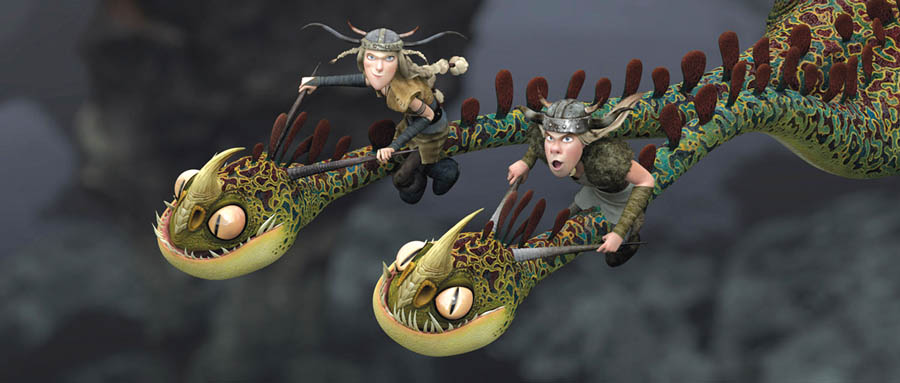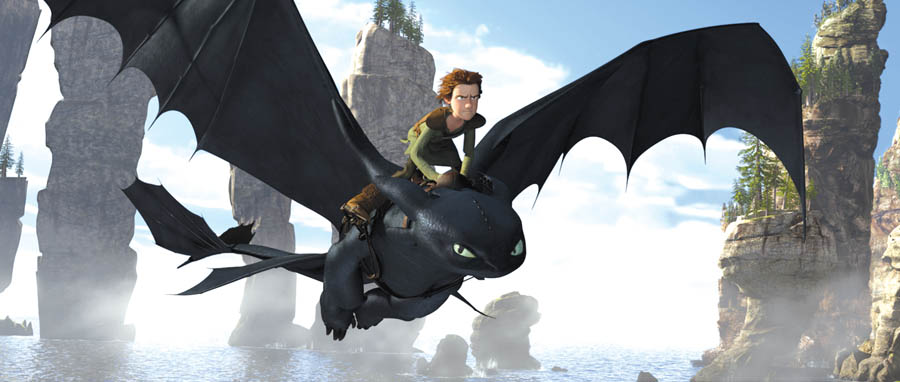 Simon Otto,
Simon Otto,
Animator Simon Otto worked for three and a half years on ‘How to Train Your Dragon’, the story of a young Viking, Hiccup, who teaches his fellow Vikings to stop battling dragons and start making friends with them. The result is a world of dragons where no animator has gone before. From Digital Media World Magazine
 |
    |
|
Simon Otto’s job on this film, Head of Character Animation, was in fact two jobs, or one with two distinct stages. The first stage began at pre-preproduction when he was working side-by-side with Character Designer Nicolas Marlet and the design team. “We shepherded all the characters from concept drawings on paper through modelling, rigging and into the final character rigs – the digital puppets. Because there were so many characters, so many rigs, it took about two years to complete all of them, starting in late 2006.” Right Hand Man Simon’s team decided to go back to a system they had employed during their 2D animation days when they assigned one supervising animator to work as the lead actor for each character. This decision was based first on the fact that Dean and Chris were very specific about what each shot needed in terms of plot and story and any special character ideas written into the script that were important to them. Second, since the team had been working for so long on the development of the characters, they also had a very precise idea of exactly how these characters should move and their idiosyncrasies, and were able to bring true acting skills to them like a stage or screen actor. This put their animation style back into a more traditional mode but with more contemporary acting, and came from the directors themselves. It made the animation one of the strongest vehicles of the story. Simon feels the ‘Forbidden Friendship’ sequence illustrates this best. “It plays out over six or seven minutes without any dialogue at all. Storyboards and animation alone carried it, no words. It was confined to those moments of character interaction and we ended up extending it by about a minute because it was working so well.” Into Production ‘It was a project that improved every step of the way, but always adhered to the same common idea. Actual shot animation began in February 2009, lasting 11 months. “We were actually supposed to start earlier,” said Simon, “but instead we devoted a team to making sure everyone knew how these characters looked and their facial expressions worked. They created very large libraries of data about their movements. For example, flap cycles ere built into the rigs to allow each dragon to move his wings and fly differently, these were developed before production specifically so the animators could dial these in when they needed them. Having libraries with categories of behaviour like these meant we could work much faster during production and to create consistent, identifiable characters.” New Species They definitely didn’t want to give the audience that classic ‘VFX dragon’. “We wanted more colourful creatures with more variation in shape, almost as if we were creating a new animal type complete with these species. Early on, when looking at the dragons emerging, we recognized an opportunity to do something never done before. Previously, a dragon has been either a visual effect that has to match a live action plate and be photorealistic, or a silly cartoony character. Mix and Match Emotive Vikings “An example is when the father Stoick loses his temper with his son Hiccup and tells him, ‘Don’t you understand – I have an entire village to feed.’ Hiccup’s response – ‘I just want to be one of you guys’ – is extremely important for the story. The animation had to remain at a very believable level.” Their eventual style resulted from very close collaboration with the directors, who were aware that by the time they arrived during pre-production, the animators had already mapped out the looks and behaviours. They took all these ideas on board on went from there. Modelling and Rigging While Simon’s job doesn’t include modelling or rigging, because of his drafting and 2D animation background, he would sit with Nicolas and the artists and did a lot of draw-overs to guide their work. For example, the first dragon they rigged, the small ‘Terrible Terror’, they painted up every expression, week by week, to show the riggers the range of facial movements they needed to achieve. They did the same for modelling, responding to their models with draw-overs. He did this mainly to make sure the designs not only looked good but would move correctly for the subsequent animations. “Each character has to move realistically, work properly and maintain design integrity – a tricky balance. Riggers are technical people, but have to be mindful of the artistic aspect of the movements. This comes with communication between the animators, designers, modellers and riggers.” Controlling the Controls “A dragon’s wing, for example, requires an animator to manipulate 150 to 200 controls to move and pose it properly. Instead they used pre-built animations with settings that can tell the computer how fast and strong each wing beat should be. These allowed them to get though very difficult and complex motions much faster and more easily. Previously, the rigs were not only less complex but animators also had to consider how long it would take the computer to re-calculate the maths involved in each motion. Now, computers can process a lot more data in less time. Complexity is possible while still working more or less in real time.” These pre-built, customizable animations work together with simulations to help animate details such as the webbing of the wings or the bouncing tip of a tail. Trying to animate all of these manually would be a mammoth job. “Because their motion is based on logic,” Simon explained, “the computer can handle it for us, while more intuitive, performance-based movement and posing still need to be done manually by an artist.” Coordinating Departments “Also important to us is the department that works directly after us, Character Effects, who help improve the cloth animations, deformation and props that we don’t have time to animate. VFX people are more concerned with fire, smoke, water, fog – things that are typically independent of characters, unless the two interact of course, or need to be animated before the character is added. Usually they can do their work parallel with us or after us.” Workflow Simon first joined Dreamworks in 1997, and said that the change to supervision by character made this film significantly different to other recent Dreamworks projects. “It made a tremendous difference on how the characters performed, on the specific ideas of each one and on the consistency of performance. This process can be very difficult to manage in a CG pipeline because you can’t control how the footage comes into the department. Usually, sequences are delivered from department to department. When you have a sequence with only one character, do have to worry about what the other supervising animators will do, but because the production period was so short and rushed they typically had plenty of footage passing through to keep everyone busy. Ramping It Up “Scaling up a rig has to be planned carefully. We managed to scale most of them up successfully but some facial controls were not fully resolved. The two-headed dragon, for example, was somewhat limited in this way. He was hard to animate in any case, with the long thin necks and tail. “Long, skinny parts are always tricky to control because they move organically and require synchronisation of inverse and forward kinetics systems, IK and FK. The head needs to be placed precisely in space and the neck has to move smoothly while you control its shape. The different methods of animating each of these may not work well together, at the same time. Dreamworks R&D is, in fact, trying to resolve this synchronisation now – but for the film, we wound up having to resolve rigging problems manually, frame by frame.” |
   |
   |
| Flap Cycles To allow each dragon his own style of flight, the riggers worked with the animators to develop flap cycles. One main cycle was built for each of the seven types of dragon, and each of these had a weak, medium and strong variation. Thus, they had to manually animate 21 different kinds of flap cycle. Included within these cycles were the associated body movements as well. They ended up making as many as 50 different cycles. To develop these, they studied hours of slow motion films and videos of birds, bats and planes figuring out, for instrance, why small birds fly differently to large ones. They learned the physics of flight, and were able to base their rigs and animation on real examples, not on other dragon movies. “This was probably our single most time-consuming task, but also saved us the most time in terms of the whole project later on. When you consider the number of sequences involving flying dragons, multiplied by the number of dragons including those involving crowds of dragons – developing those cycles saved us a tremendous amount of time. Furthermore, each performance would run through several cycle speeds within one scene, from slow to fast, so we had to make sure they would work together and blend into each other.” |
| Words: Adriene Hurst with simon otto Images: Paramount Pictures and Dreamworks Animation |
| Featured in Digital Media World. Subscribe to the print edition of the magazine and receive the full story with all the images delivered to you.Only$77 per year. PDF version only $27 per yearsubscribe |


















